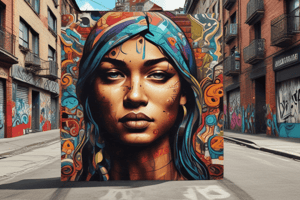Podcast
Questions and Answers
Graffiti originated in ancient Greece and Rome as a form of artistic expression.
Graffiti originated in ancient Greece and Rome as a form of artistic expression.
False (B)
Murals are typically small-scale paintings or artworks on a wall or building.
Murals are typically small-scale paintings or artworks on a wall or building.
False (B)
Stenciling is a street art style that uses paper or canvas attached to a surface using a wheat-based adhesive.
Stenciling is a street art style that uses paper or canvas attached to a surface using a wheat-based adhesive.
False (B)
3D Street Art involves creating two-dimensional artworks that appear flat on the wall.
3D Street Art involves creating two-dimensional artworks that appear flat on the wall.
Tagging is a type of graffiti that involves creating large, intricate murals.
Tagging is a type of graffiti that involves creating large, intricate murals.
Bombing is a type of graffiti that involves quickly painting multiple graffiti in a short period of time.
Bombing is a type of graffiti that involves quickly painting multiple graffiti in a short period of time.
Throwing up is a type of graffiti that involves creating large, intricate murals.
Throwing up is a type of graffiti that involves creating large, intricate murals.
Murals are often used to convey social messages and promote community engagement.
Murals are often used to convey social messages and promote community engagement.
Abstract Street Art is a style that focuses on realistic representations of objects and scenes.
Abstract Street Art is a style that focuses on realistic representations of objects and scenes.
Pop Art is a street art style that uses stencils to create detailed, multi-layered designs.
Pop Art is a street art style that uses stencils to create detailed, multi-layered designs.
Flashcards are hidden until you start studying
Study Notes
Graffiti
- Definition: Writing or drawing on a surface, usually in a public place, without permission
- Origins: Ancient civilizations, such as Greece and Rome, used graffiti to express political and social opinions
- Modern graffiti: Emerged in the 1970s in New York City, associated with hip-hop culture and youth rebellion
- Types of graffiti:
- Tagging: Simple, stylized writing of an artist's name or initials
- Throwing up: More complex designs, often including colors and shapes
- Piece: Large, intricate murals
- Bombing: Quickly painting multiple graffiti in a short period of time
Murals
- Definition: Large-scale paintings or artworks on a wall or building
- History: Date back to ancient civilizations, such as the Egyptians and Greeks
- Modern murals: Often used to beautify urban spaces, promote community engagement, and convey social messages
- Characteristics:
- Large scale: Can cover entire buildings or city blocks
- Permanent: Intended to be long-lasting, unlike graffiti
- Collaborative: Often created by multiple artists or with community involvement
- Thematic: May focus on social issues, cultural heritage, or local identity
Street Art Styles
- Stenciling: Using templates to create detailed, multi-layered designs
- Famous artists: Banksy, Blek le Rat
- Wheatpasting: Attaching paper or canvas to a surface using a wheat-based adhesive
- Famous artists: Swoon, Fafi
- 3D Street Art: Creating three-dimensional artworks that appear to jump off the wall
- Famous artists: Pavement Chalk Art, Manfred Stader
- Abstract Street Art: Non-representational artworks that focus on color, shape, and texture
- Famous artists: Space Invader, Invader
- Pop Art: Using popular culture icons and imagery to create bold, colorful artworks
- Famous artists: Andy Warhol, Jean-Michel Basquiat
Graffiti
- Graffiti is writing or drawing on a surface, usually in a public place, without permission
- Originated in ancient civilizations, such as Greece and Rome, to express political and social opinions
- Modern graffiti emerged in the 1970s in New York City, associated with hip-hop culture and youth rebellion
- Types of graffiti include:
- Tagging: simple, stylized writing of an artist's name or initials
- Throwing up: more complex designs, often including colors and shapes
- Piece: large, intricate murals
- Bombing: quickly painting multiple graffiti in a short period of time
Murals
- Definition: large-scale paintings or artworks on a wall or building
- Date back to ancient civilizations, such as the Egyptians and Greeks
- Modern murals are often used to beautify urban spaces, promote community engagement, and convey social messages
- Characteristics include:
- Large scale: can cover entire buildings or city blocks
- Permanent: intended to be long-lasting, unlike graffiti
- Collaborative: often created by multiple artists or with community involvement
- Thematic: may focus on social issues, cultural heritage, or local identity
Street Art Styles
Stenciling
- Using templates to create detailed, multi-layered designs
- Famous artists include Banksy and Blek le Rat
Wheatpasting
- Attaching paper or canvas to a surface using a wheat-based adhesive
- Famous artists include Swoon and Fafi
3D Street Art
- Creating three-dimensional artworks that appear to jump off the wall
- Famous artists include Pavement Chalk Art and Manfred Stader
Abstract Street Art
- Non-representational artworks that focus on color, shape, and texture
- Famous artists include Space Invader and Invader
Pop Art
- Using popular culture icons and imagery to create bold, colorful artworks
- Famous artists include Andy Warhol and Jean-Michel Basquiat
Studying That Suits You
Use AI to generate personalized quizzes and flashcards to suit your learning preferences.




